The Lynnfield Preview: Rumblings of Revenge
by Anand Lal Shimpi on May 29, 2009 1:00 PM EST- Posted in
- CPUs
SYSMark 2007 Performance
Our journey starts with SYSMark 2007, the only all-encompassing performance suite in our review today. The idea here is simple: one benchmark to indicate the overall performance of your machine.
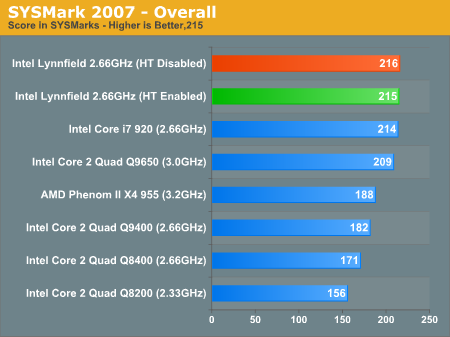
Ok. Right out of the gate, on pre-production silicon, with a pre-production motherboard and without a super aggressive turbo-mode the 2.66GHz Lynnfield sample is able to perform just as well as the i7-920. This is just as we expected given the minimal impact of triple-channel DDR3 on i7 that we pointed out in our original review.
Curiously enough, HT doesn't seem to do anything at all for Lynnfield in this test. Remember that stressing four cores is tough enough, finding eight CPU intensive threads is even more difficult.
Adobe Photoshop CS4 Performance
To measure performance under Photoshop CS4 we turn to the Retouch Artists’ Speed Test. The test does basic photo editing; there are a couple of color space conversions, many layer creations, color curve adjustment, image and canvas size adjustment, unsharp mask, and finally a gaussian blur performed on the entire image.
The whole process is timed and thanks to the use of Intel's X25-M SSD as our test bed hard drive, performance is far more predictable than back when we used to test on mechanical disks.
Time is reported in seconds and the lower numbers mean better performance. The test is multithreaded and can hit all four cores in a quad-core machine.

DivX 8.5.3 with Xmpeg 5.0.3
Our DivX test is the same DivX / XMpeg 5.03 test we've run for the past few years now, the 1080p source file is encoded using the unconstrained DivX profile, quality/performance is set balanced at 5 and enhanced multithreading is enabled:
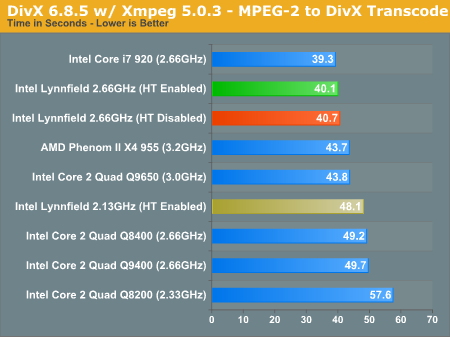
Once more, we see very little impact from Hyper Threading; the entry level Lynnfield may not be as bad as you'd think. On top of that, the crippled Lynnfield is less than 4% slower than the Core i7-920. Enable its aggressive turbo mode and I believe we'll have a chip that can actually beat, even if only slightly, the Core i7-920.
x264 HD Video Encoding Performance
Graysky's x264 HD test uses the publicly available x264 codec (open source alternative to H.264) to encode a 4Mbps 720p MPEG-2 source. The focus here is on quality rather than speed, thus the benchmark uses a 2-pass encode and reports the average frame rate in each pass.
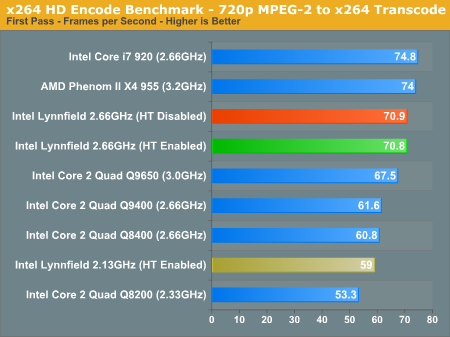
The x264 encode test shows one application where Hyper Threading is important. A 2.13GHz Lynnfield with HT enabled is faster than a 2.66GHz Lynnfield with HT disabled, unfortunately the former isn't on the roadmap and the latter is what we're getting.
Without HT enabled the $196 Lynnfield 2.66GHz core is faster than every non-EE Penryn Core 2 Quad as well as AMD's Phenom II X4 955 (in the second pass of the test). The i7-920 is significantly faster thanks to having HT enabled; and now we have the perfect reason for Intel disabling HT on the "low end" Lynnfield.
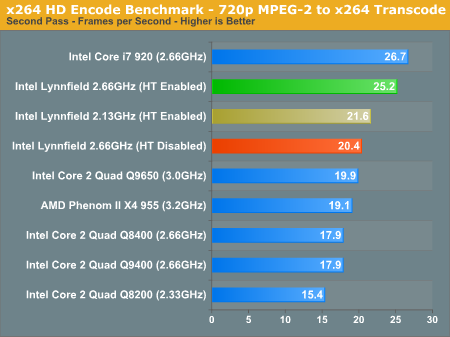
Windows Media Encoder 9 x64 Advanced Profile
In order to be codec agnostic we've got a Windows Media Encoder benchmark looking at the same sort of thing we've been doing in the DivX and x264 tests, but using WME instead.
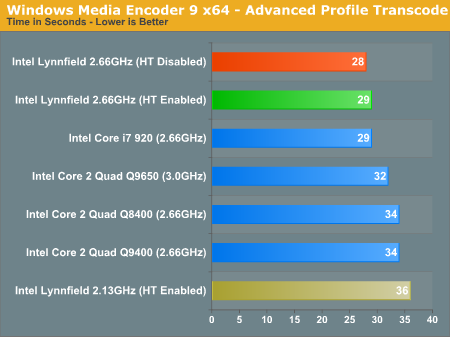
Tests that don't scale well with HT enabled, once again, show no performance difference between a 2.66GHz Lynnfield and a 2.66GHz Bloomfield.










95 Comments
View All Comments
Seramics - Sunday, May 31, 2009 - link
Why is it that in test that demand intensive multi threading, the lynnfield loses out to bloomfield while in less intensive multithreaded or single threaded test, the lynnfield can equal bloomfield? Could it be that in intensive multithreading processing that work up more than 4 threads (thereby requiring the use of HT for better performance), it is able to use the extra memory bandwith provided by triple channel in the bloomfield platform? Maybe in situation where the software can really demand mutlple threading processing intensively, the bloomfield extra memory bandwith provide an edge. An easy way to test this is increasing the memory bandwith of lynnfield and/or decreasing memory bandwith of bloomfield n see wht happens in intensive multithreaded test. Im suspicious of this. Let me know wht u guys thinks.IntelUser2000 - Sunday, May 31, 2009 - link
The Turbo Modes for revealed for Lynnfield way before even Core i7's release.1 core: +5(+4 for non-HT version)
2 core: +3
4 core: +1
It may or may not be coincidence, but the Turbo speed of the highest clock Lynnfield is equal to the Turbo speed of the highest Core i7. The point is, I think since people will overclock the "enthusiast" i7's anyway, the Turbo doesn't need to be so high.
According to Intel, the benefits will be GREATER on smaller form factors, which means laptops will have even HIGHER increases.
RagingDragon - Sunday, May 31, 2009 - link
Hmmm... I'm not sure how much sense Lynnfield will make in the long term - at the high end you'll have Bloomfield on LGA-1366, and at the low end Clarkdale/Arrandale on LGA-1156. I'm not sure if there's enough room between them for Lynnfield, though I guess it does provide an easy upgrade option for inexpensive OEM systems which need to support Clarkdale.brightstar - Sunday, May 31, 2009 - link
I'll wait and see how this pans out, but as of right now the I5 sounds like the new Celery proc to meJS - Saturday, May 30, 2009 - link
"...to protect the innocent"I guess you really wanted to say "to protect my sources". I'm guessing they are not innocent at all, unless you actually stole the stuff from them. ;o)
mybook4 - Saturday, May 30, 2009 - link
The article mentions that Lynnfield will have a new turbo mode that clocks much higher. I was thinking of reasons why intel might put this feature into the mainstream i5 rather than making the feature exclusive to the i7. Then I remembered that the PCIe controller was integrated into the core.To overclock a multiplier locked i5, you would have to increase the base clock. Not sure, but I believe this would also overclock the PCIe controller (something which may not be as tolerant of overclocking).
This might explain why the new high end turbo mode would be included in the i5. You lose high overclocking potential (which would attract overclockers to i7), but in exchange, the i5 does decent overclocking for you.
pyn - Saturday, May 30, 2009 - link
is it possible that we will see turbo modes similar to lynnfield in gulftown? also, is intel going to release any 8 core / 16 thread nehalem processors targeted towards desktop systems or is the nehalem-ex likely to be the only 8 core nehalem we will see?mmpalmeira - Saturday, May 30, 2009 - link
Why did you use the Lynnfield in a 2.66Ghz configuration with HT on if there wont be models like that in the market?Anand Lal Shimpi - Saturday, May 30, 2009 - link
I did that to show what sort of performance having HT enabled is responsible for. Intel isn't making a 2.13GHz HT enabled Lynnfield either, but I ran those tests because they're interesting to look at :)Take care,
Anand
Drazick - Saturday, May 30, 2009 - link
Will the P55 support USB 3, SATA 3, UEFI?When will we see all those features in the chipsets, which for me, are much more important than the i5 by itself.
What about the new Chiopsets, are they SSD optimized?